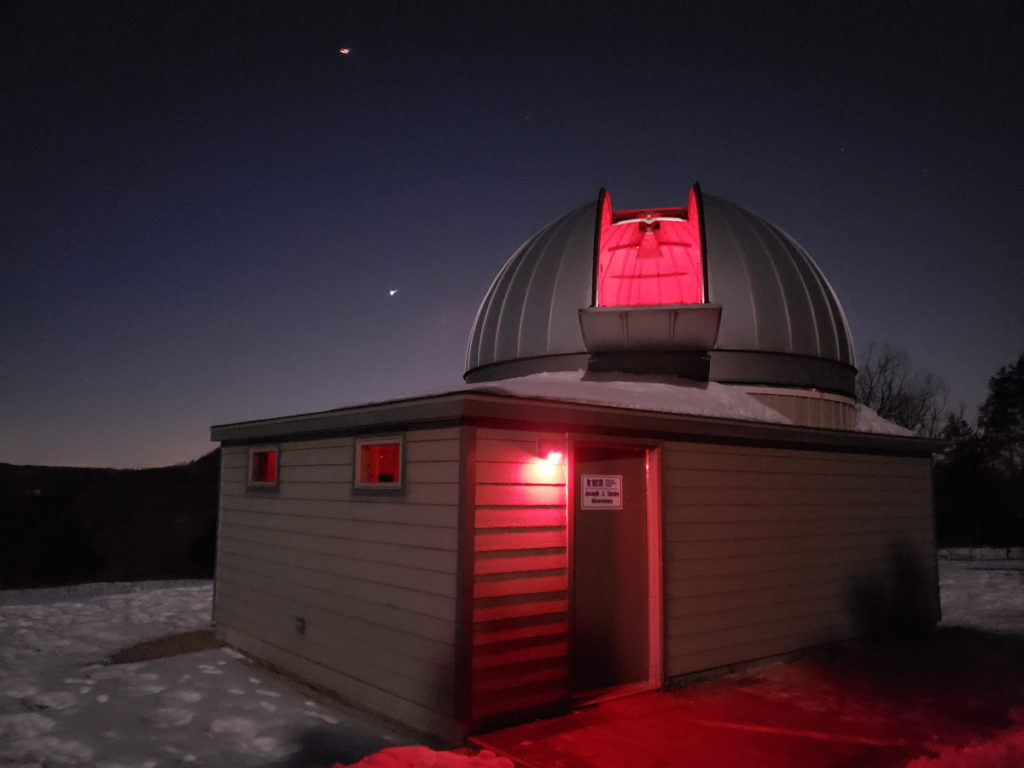This article first appeared in The Meadowlark in 2017.
“It has been said that astronomy is a humbling and character-building experience. There is perhaps no better demonstration of the folly of human conceits than this distant image of our tiny world. To me, it underscores our responsibility to deal more kindly with one another, and to preserve and cherish the pale blue dot, the only home we’ve ever known.”
– Carl Sagan, Pale Blue Dot
The time was the 1970s and space exploration had fully captured the public imagination. With the first moon landing in 1969, children and adults alike were inspired to pursue astronomy by a new sense of possibility regarding what might exist within and beyond our solar system.
Andy Fraser was one of those captivated by outer space. Fraser, who grew up in Western Michigan and now lives in Afton, recalls learning constellations from his father while they were night sledding. While he intended to pursue a career in astrophysics or aerospace engineering, the close of the manned lunar program led him to a more conventional career. Only at the age of 67 did he earn a Master of Science in Astronomy.
“The study of astronomy for me affords a nearly religious experience, as we contemplate the scale of it all,” Fraser says. “To quote another native of Western Michigan and a renowned astronomer, Heber D. Curtis, ‘The undevout astronomer is mad’ and ‘The more I know of astronomy, the more I believe in God.’”
Fraser is a former vice president of the Minnesota Astronomical Society (MAS) and was one of the founding members of the club in the early 1970s. Today, MAS boasts nearly 500 members, both professional and amateur astronomers, and is one of the largest and most active such clubs in the country.
MAS has multiple astronomical viewing sites throughout the Twin Cities, including several at Belwin Conservancy. In 2009, members built the Joseph J. Casby Observatory near Belwin’s Education Center. This is a permanent facility mainly used by MAS for their events; however, members open the observatory to the public during select Belwin events like the upcoming Midwinter Family Fun event on February 5, 2022.

Inside the observatory is an 8-foot-long, 10-inch TMB Apochromatic Refracting telescope, one of the largest amateur society owned and operated refracting telescopes in the U.S. “The facility and its instruments are extremely well equipped, including guide scopes, eyepieces, filters and solar instrumentation,” Fraser says.
“The observatory allows Belwin program attendees a glimpse into our solar system and to other galaxies in our vast universe,” says Susan Haugh, Belwin’s Program Director.
While our knowledge of the universe has exploded since the moon landing in 1969, it also has revealed to us that our planet is one of a kind. Because of Earth’s unique ability to host life, we are motivated to protect and cherish what we have.
As Carl Sagan wrote in his novel Pale Blue Dot, “Our planet is a lonely speck in the great enveloping cosmic dark. In our obscurity, in all this vastness, there is no hint that help will come from elsewhere to save us from ourselves. … Like it or not, for the moment the Earth is where we make our stand.”
Weather-permitting, MAS members will open the Joseph J. Casby Observatory to the public during Belwin’s Midwinter Family Fun event from 5:00 p.m. to 7:00 p.m. on February 5, 2022. Get complete event details here.
VOYAGER 1’s “Pale Blue Dot” image
The lead image for this blog post is an image of Earth, one of 60 frames taken by the Voyager 1 spacecraft from a distance of more than 6 billion kilometers and about 32 degrees above the ecliptic plane. In the image the Earth is a mere point of light, a crescent only 0.12 pixel in size.
“The Pale Blue Dot is an iconic photograph of Earth taken on Feb. 14, 1990, by NASA’s Voyager 1 spacecraft.
“Voyager 1 was speeding out of the solar system — beyond Neptune and about 3.7 billion miles (6 billion kilometers) from the Sun — when mission managers commanded it to look back toward home for a final time. It snapped a series of 60 images that were used to create the first “family portrait” of our solar system.
“The picture that would become known as the Pale Blue Dot shows Earth within a scattered ray of sunlight. Voyager 1 was so far away that — from its vantage point — Earth was just a point of light about a pixel in size. …
“Carl Sagan played a leading role in the U.S. space program. The prominent planetary scientist was a consultant and adviser to NASA beginning in the 1950s. He briefed the Apollo astronauts before their flights to the Moon.
“In his role as a visiting scientist at JPL, Sagan helped design and manage the Mariner 2 mission to Venus; the Mariner 9, Viking 1 and Viking 2 trips to Mars; the Voyager 1 and Voyager 2 missions to the outer solar system and the Galileo mission to Jupiter.
“Sagan also was a member of the Voyager Imaging Team. He had the original idea in 1981 to use the cameras on one of the two Voyager spacecraft to image Earth. He realized that because the spacecraft were so far away the images might not show much. This was precisely why Sagan and other members of the Voyager team felt the images were needed — they wanted humanity to see Earth’s vulnerability and that our home world is just a tiny, fragile speck in the cosmic ocean.”
Photo courtesy NASA.